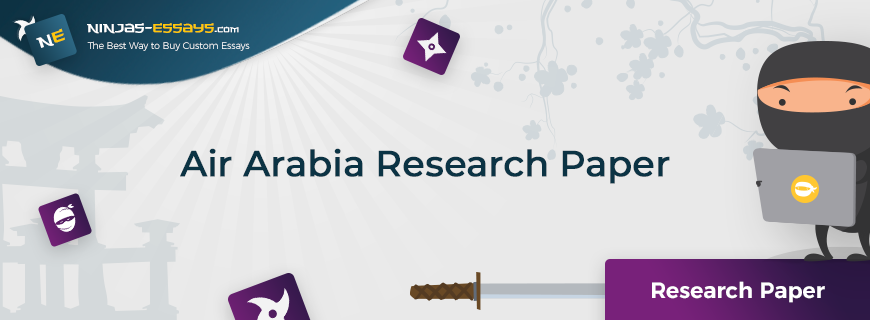
Executive Summary
Air Arabia is the UAE airline company that has already operated almost fifteen years on the market. During this period it has become one of the leading airline companies in the world. It has won many awards, including the ISO/IEC 20000-1: 2011 certificate in IT Service Management System due to its own engineering system. It has also the advanced and well-constructed internal control system. However, it has not received the ISO 9001:2008 certificate in quality management systems which is very important in the airline industry, as well as in all industries. The customers focus on the quality when choosing the company.
Thus, it is necessary to find out the reasons of the fact that Air Arabia has not received the certificate, the weaknesses and difficulties of the company regarding to this point, making the gap analysis. In this regard the future state of the company is the implemented quality management system with defined scope, defined influencing factors, leadership, defined and managed risks and resources, with implemented planning stage, established measurement and monitoring, and constantly improving. The current state is the implemented internal control system, defined influencing factors, leadership, defined and managed risks, established measurement and monitoring, and constantly improving. So, the gap consists of not implemented quality management system, not established planning stage, not defined resources, and not documented all the processes. In conclusion, in order to bridge this gap, and therefore receive the ISO 9001:2008 certificate, Air Arabia should implement the quality management system and define its scope, make planning at all stages and for all processes, define necessary resources at all stages and for all processes, and create documents for all processes and make them available for everyone.

Best Essay Writing
Services

Need Custon Writen Paper? We'll Write an essay from scratch according to your instructions
Abstract
The purpose of the current report is to identify the measures, which Air Arabia should implement in order to receive the ISO 9001:2008 certificate. The problem is that there is a significant gap between the requirements specified in the standard and the current state of the company. In order to reach the respective purpose, there is analyzed report of Air Arabia and the available information provided on its website as well as precisely studied ISO 9001:2008 standard. The paper identified that in addition to already established measures, the Air Arabia should adopt separate quality management system, implement planning stage at all levels, and document all the processes in order to fill the existing gap.
Keywords: ISO 9001:2008, quality management system, Air Arabia, planning, resources
You can Buy 3000 word essay on this or any other topic at Ninjas-Essays. Don’t waste your time, order now!
Air Arabia
The Company
Air Arabia is the first low-cost air carrier in the Middle East, which offers flights to 89 cities around the world (Air Arabia, n.d.). In fact, the low-cost carrier is an airline company that provides very low fares for flights, saving on the comfort of passengers. To compensate for losses from cheap tickets, they charge fees for additional options, such as food and drinks on board, etc. Air Arabia differs from many low-cost carriers in a way that it offers flights between destinations with a transfer at the Sharjah base airport. It also provides a free luggage transportation service (Air Arabia, n.d.).
The vision of the company is one of the leading budget airlines in the world with regard to profitability, innovation, reputation, and operational excellence. The company’s mission is to fundamentally change the air travel in the region through innovation providing excellent price-quality ratio and safe and reliable operation (Air Arabia, n.d.).
Air Arabia was established on February 3, 2003 by decree of Emir Sharjah Sheikh Sultan bin Mohammed Al-Qasimi III. The airline started to operate on the 28th of October, in 2003. It conducted the first flight from Sharjah to Bahrain International Airport (Air Arabia, n.d.). In August 2016, the Air Arabia fleet consisted of 38 Airbus A320 aircrafts with an average age of 2.8 years. All aircrafts have a one-class layout on 162 (168) seats (economy class) being equipped with an individual entertainment system, which is available at an additional cost (Air Arabia, n.d.).
Air Arabia is listed on the Dubai Financial Market under the symbol DFM:AIRARABIA. In early 2007, it began a successful initial public offering of 55% of its shares on the stock exchange (Air Arabia, n.d.). The company has already distributed 3 billion dirhams in dividends to its shareholders. Currently, the organization is the owner of assets worth of 12 billion dirhams, and the net profit in the year 2016 accounted for 509 million dirhams. The airline reached such benefit due to 65 million passengers it has already carried (Air Arabia, n.d.).
Air Arabia is a holding company and comprises group of companies, both airlines as well as travel and tourism companies located worldwide. Thus, it operates from 5 international hubs: in Sharjah and another airport in the UAE as well as airport in Morocco, Egypt, and Jordan (Air Arabia, n.d.). The airline has 4 affiliated companies. The first is Fly Yeti (2007-2008). In 2007, Air Arabia signed a joint venture agreement with Nepalese Yeti Airlines and opened a base in Nepal’s capital Kathmandu (Air Arabia, n.d.). The airline expected that the new air carrier Fly Yeti would provide affordable and convenient air transportation for a wide range of international destinations in Asia and the Middle East. At the initial stage, the company used 1 Boeing 737-800 aircraft, carrying out flights in 4 directions from Nepal (Air Arabia, n.d.). Due to the uncertain political and economic situation in Nepal and the lack of support from the local government, the activities of the Fly Yeti have been suspended since the beginning of 2008 (Air Arabia, n.d.). The second one is Air Arabia Maroc (since 2009). This company, together with other investors, established a subsidiary airline in the largest city of Morocco, Casablanca. Air Arabia Maroc began to operate on May 6, 2009, allowing the expansion of Air Arabia’s transportation network to Africa and Europe (Air Arabia, n.d.). The fleet of Air Arabia Maroc currently consists of four aircraft and operates flights to 12 destinations in 7 countries, mainly to Europe. The third one is Air Arabia Egypt (since 2010). On September 9, 2009, the given company announced the establishment of a joint venture in Egypt with the tourist group Travco, which would be based at the airport of Alexandria. The new airline was licensed for operational activities on May 22, 2010, and provided the first flight on June 1, 2010 (Air Arabia, n.d.). The fleet in Egypt currently consists of three aircrafts and scheduled flights to 10 destinations in 7 countries. The fourth one is Air Arabia Jordan. On June 7, 2010, Air Arabia announced that it had signed a contract with the Tantash group to establish Air Arabia Jordan, which would be based in Amman, Jordan (Air Arabia, n.d.). The company planned that the subsidiary airline would operate flights from the international airport of Amman to the countries of Europe, the Middle East, and North Africa. On June 14, 2011, Air Arabia announced the postponement of plans to create a hub in Jordan due to the unstable political situation in the country and the regional increase in fuel prices. However, the airline renovated operations in May 2015 (Air Arabia, n.d.).
The company located its headquarters on the territory of Sharjah International Airport, which is 15 kilometers from the central part of Dubai (Air Arabia, n.d.). The board of directors includes 7 members: Sheikh Abdullah Bin Mohammed Al Thani is Chairman of the Board, Adel Abdullah Ali and Aref Naqvi Non – executive members, Dr. Ghanem Mohammed Al Hajri, Sheikh Mohammed Bin Abdullah Al Thani, Sheikh Khalid Bin Issam Al Qassimi, and Ali Salim Al Midfa – independent members (Air Arabia, n.d.). The corporate structure of the company is provided in the appendix A. Reviewing he structure of the company, it is evident that it created special committees responsible for particular things, such as Audit Committee, Nominations and Remuneration committee, and Internal trading Supervision Committee (Air Arabia, n.d.). Air Arabia has also the internal control system. The given system controls and evaluates the compliance with policies and procedures as well as property protection and efficient utilization of the resources. To a greater extend, due to the internal control system on both local and international levels, the world community recognized Air Arabia for the high performance and community efforts. Thus, in 2016, it received many awards, including Best Low-cost Airline Serving the Middle East, Best Value Leisure Product Award, Corporate Social Responsibility Initiative of the Year, and many others . Moreover in 2012, the company was awarded with the ISO/IEC 20000-1: 2011 certificate in IT Service Management System. However, the airline still has not received the ISO 9001:2008 certificate in quality management systems (Air Arabia, n.d.). The following information will reveal the reasons, for which the company failed to receive the respective certificate.
Gap Analysis
Identifying the Future State
Considering the fact that Air Arabia is intent on establishing the ISO 9001:2008, the future state of the company will be assessed according to its requirements. Moreover, if the organization fails to follow these demands, it will not be able to adopt corresponding standard. It defines the requirements for quality management systems that an airline must perform in order to demonstrate its ability to provide products that meet the demands of consumers and the applicable mandatory requirements (ISO 9001, 2008).
First, the company should establish the quality management system, including all the necessary processes, which they will continuously maintain and improve. The organization can implement process and system management by using the Plan-Do-Check-Act methodology with a common focus on risk-based thinking aimed at realizing positive opportunities and preventing undesirable results (ISO 9001, 2008). The PDCA cycle is shortly depicted in the Appendix B. The company should also define the responsibilities and actions of the quality management system in order to envisage all important tasks and execute them efficiently. In addition, the company should define and study the external and internal factors that are significant in terms of its objectives having the influence on company’s strategy and influencing the activities of the quality management system as well as its ability to reach the established objectives (ISO 9001, 2008). Moreover, the airline should be aware of the needs and expectations of their stakeholders regarding the quality, thus ensuring efficiency of the quality management system.
Second, the senior management of the company should manifest the leadership and interest in the efficiency of the quality management system. In this regard, it should bear responsibility for its effectiveness and ensure that the policy and goals of the quality management system do not contradict the overall strategy and direction of the entire company. In addition, the management should ensure that the quality management system’s requirements are at the core of the company’s business, provide the availability of the resources necessary for the system, and ensure that the system achieves the expected goals. Moreover, the top management should also promote the process approach and risk assessment approach in each operation, communicate the significance of the quality management system and the importance of meeting the set requirements. Finally, it is important to target, support and encourage the personnel in order to ensure the system’s efficiency as well as promote constant improvement and demonstration of leadership at all levels (ISO 9001, 2008).
Third, the company should plan actions to handle risks and implement opportunities, set the goals and expected result for all the processes of quality management system at all levels as well as to plan possible changes (ISO 9001, 2008).
Fourth, the company should define all the necessary resources for the efficient operation of the quality management system, considering and providing the possibilities and limitations of available internal resources (ISO 9001, 2008). This also involves provision of such resources as employees that play important role in the quality management system functioning as well as the entire company (HR Air Arabia, n.d.). The organization should also determine and maintain the infrastructure and environment for the functioning of its processes to achieve conformity of services. Moreover, in cases, where monitoring and measurements are used to obtain evidence that the services conform to the specified requirements, the organization shall determine necessary resources to guarantee suitability and reliability of the provided data (ISO 9001, 2008).
Fifth, the organization should plan, implement and manage the processes necessary to ensure compliance with the requirements for the delivery of services (ISO 9001, 2008). It should also define the requirements regarding the services. This involves establishment of communication with the consumers and corresponding analysis before making commitments to provide services to the customers. In addition, it is important to establish the design and development processes as those preceding the provision of services (ISO 9001, 2008). In case when resources, goods and services are supplied from external companies or individuals, a process of checking whether they meet the necessary quality requirements is necessary. Generally, it is necessary to produce the services under managed and controlled conditions (ISO 9001, 2008). Moreover, the company should not release services for the consumers until it successfully plans the activities or until the authorized person gives permission for such a delivery. Finally, the company should ensure it is able to identify, manage, and increasingly perform all the resources and operations that do not meet the requirements (ISO 9001, 2008).
Sixth, the company should define the requirements of monitoring and measurement, namely its methods, where to implement them, the timeframes of analyzing and evaluating the results (ISO 9001, 2008). In particular, the company should assess the level of satisfaction of the consumers. In addition, it should conduct internal audits at the regular basis to obtain necessary information about the efficiency of the quality management system and to define weaknesses that should be managed (ISO 9001, 2008).
Finally, the company should constantly seek improvement, despite the level of quality and net profits, as well as use any opportunity to meet the consumers’ requirements and improve their satisfaction. While identifying the non-compliance, the organization shall respond to the discrepancy as well as manage the mismatch and correct it (ISO 9001, 2008).
Identifying the Current State
First, Air Arabia has established the internal control system as well as defined its respective scope. It constantly monitors the external and internal factors influencing the company. Thus, it found weakening currencies, vigilant fiscal markets and political instability having negative impact on airlines performance. In addition, it monitors culture and values among employees by using Employee Self Service Portal (Air Arabia, n.d.). Moreover, in order to identify stakeholders and their requirements, the company conducts the summit “voice of industry” annually where it established the discussion on a variety of topics relevant to key stakeholders (Air Arabia, n.d.).
Second, the management of Air Arabia demonstrates leadership and responsibilities. In 2016, the CEO of the company was named the “Airline CEO of the Year” (Air Arabia, n.d.). It ensures that the duties and responsibilities are accurately distributed. Thus, the Board of directors reviews the company strategically, establishes and reviews strategies using executive management, which is led by the CEO and responsible for day-to-day activities reporting to the Board (Air Arabia, n.d.).
Third, Air Arabia also defines and manages the risks with its internal control system. Thus, despite all challenges and risks, the company recorded solid full year results, such as the 34% growth in net profit in Q2, 12% increase in passenger traffic, etc. In addition, the company establishes goals, thus, exceeding the fleet with 50 aircrafts (Air Arabia, n.d.).
Fourth, Air Arabia identifies and provides the necessary resources for the quality management system by using its internal control system as well as the human resources due to respective nominations and remuneration committee (Air Arabia, n.d.). In addition, it defines key competences and responsibilities for each human resource. Moreover, it maintains infrastructure due to the assistance of Air Arabia Engineering. The company maintains all parts of the Airbuses A320 as well as line maintenance, employs only licensed employees, and provides non-destructive testing, for which the company succeeded to receive the ISO/IEC 20000-1: 2011 (Air Arabia, n.d.).
Fifth, Air Arabia is able to meet the requirements of the consumers, which it manifests in the unique services. Thus, it is evident considering the cheap tickets due to lowered buying ability, web check-in for people who lack the time or are in delay, etc. It communicates with the customers through its website and numerous social media. In addition, the company cooperates only with qualified service providers (Air Arabia, n.d.). The airline ensures that the production of services corresponds to the managed conditions.
Sixth, Air Arabia evaluates its performance using its internal control system. It conducts an internal audit due to its Audit Committee that consists of 3 persons, Internal Control Department headed by certified internal auditor as well as external accounts auditor that is KPMG (Air Arabia, n.d.). The internal audit also involves the analysis of management.
Finally, the internal control system is responsible for improvements of operating performance, existing policies and procedures, the effectiveness of control, governance process, and risk management (Air Arabia, n.d.). The entire information is documented and presented in the company’s annual report.
Describing the gap
There exists a significant gap between the future and current state of Air Arabia, due to which the company has not obtained the ISO 9001:2008 certificate yet. The gap constitutes all aspects of ISO 9001:2008, including context of the company, leadership, planning, provision, functioning, performance evaluation, and improvement. First, the airline lacks quality management system possibly due to the existence of internal control system intended for management of all the operations, though the “quality management” is not included in the list of its responsibilities. Second, it is possible to state that the company does not have policy regarding quality possibly for the reason that it is not documented. Third, the most important fact is that in Air Arabia, the process approach is omitted or is not completed since the stage of planning is almost absent. Thus, the company does not establish quality goals without planning to achieve them. Moreover, it does not envisage possible actions, required resources, time of their achievement, as well as the necessary changes. This could be due to the instable industry or to the lack of documented facts. Fourth, Air Arabia does not maintain the order in the working environment that involves absence of discrimination, especially between genders, protection from negative emotions, and noise. This depends on the culture of the UAE and peculiarity of work. In addition, there is also a significant gap in functioning. Air Arabia fails to determine requirements for services and establish criteria for processes. In addition, the management of the company does not possess information on the accepted quality of products and services from external suppliers as well as not able to identify the number and quality of resources necessary to meet the requirements for services, etc. This is due to the absence of planning stage. Finally, the Air Arabia does not determine the requirements of monitoring and measurement, their methods, and cases to which they are applicable. This is also due to the absence of planning stage. In addition, it does not provide documented information as evidence of management analysis results.
Bridging the Gap
First, in addition to the existing internal control system, it is important to establish the quality management system. Moreover, it is necessary to determine its scope of functioning, providing the ability to effectively manage the quality issues and to the full extend as it would be responsible for quality issues exclusively. Further, it is important to implement the planning stage in all process and at all levels in order to predict the outcomes and be able to control and manage them. In this regard, the company should establish annually the requirements for services provided as well as define methods to be used during the measurement of conformity. In addition, Air Arabia should employ women in managerial positions who can add some new visions as well as control level of noise by establishing particular noise isolators in the airports. Finally, it should document all the plans, processes, check result, etc. and make it available to the public in order to facilitate the control process and provide the ability for the consumers to accurately assess the company’s operations.
Conclusion
In conclusion, Air Arabia is one of the best airlines in the world and the first low-cost airline in the Middle East. It is popular among the consumers of the industry with constantly growing amount of passengers they carry. Due to its successful operations, the company’s net profit also significantly increases reaching 509 million dirhams in the last year. In addition, it has won many awards, among which they received ISO/IEC 20000-1: 2011 certificate in IT Service Management System. However, Air Arabia has not received ISO 9001:2008 certificate yet in Quality Management System.
ISO 9001:2008 is based on the principles of quality management, such as customer orientation, leadership, staff involvement, process approach, improvement, making decisions based on evidence, and management of communications. Thus, in accordance with its requirements for the creation of a quality management system, the company should implement the following tasks: define the necessary processes for the quality management system and applicate them; define and establish criteria and methods of ensuring and controlling the efficiency of the system and operations, including monitoring and measurement; define and ensure the availability of the resources necessary for all this activities; appoint responsible persons who will have the authority to monitor these processes; consider risks and opportunities; control and assess the processes; make any changes necessary to reach the expected result; constantly seek improvement of the processes and operations as well as quality management system.
There is a significant gap between the current state of Air Arabia and the requirements specified in the standard. In order to fill this gap, the company should establish separate quality management system, implement planning stage at all levels, including establishment of requirements related to the resources. Finally, the organization should document all the processes, operations, plans, and demands, ensuring that this information is available to the public.



